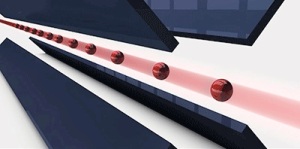Sep 4 2013
Researchers from the universities in Mainz, Frankfurt, Hamburg, and Ulm have proposed a new platform for quantum simulation. In a theoretical paper recently published in Physical Review Letters, they show that a combined system of ultracold trapped ions and fermionic atoms could be used to emulate solid state physics.
 The figure schematically shows a Paul trap with four main electrodes, in which a crystal of Yb+ ions is trapped and overlapped with an optically-trapped cloud of lithium ions. Ill.: Ferdinand Schmidt-Kaler
The figure schematically shows a Paul trap with four main electrodes, in which a crystal of Yb+ ions is trapped and overlapped with an optically-trapped cloud of lithium ions. Ill.: Ferdinand Schmidt-Kaler
This system may outperform possibilities of existing platforms as a number of phenomena found in solid state systems are naturally included, such as the fermionic statistics of the electrons and the electron-sound wave interactions.
Quantum simulation was first proposed by Richard Feynman in 1982. He realized that a calculation of quantum systems is well beyond the ability of any existing computer technology. This is because quantum mechanics features superpositions and entanglement; its dynamics follows many pathways simultaneously. Even the most powerful classical computers lack the computing power to keep track of all those possible outcomes even for small quantum systems. Feynman proposed using an easily accessible and easily controllable laboratory quantum system to mimic the quantum system of interest. This idea is reminiscent to using a crash test dummy to simulate the dynamics of a collision in the classical world.
In their recent paper, the authors calculate that an ion crystal and a degenerate Fermi gas mimic a solid state system built up of atomic cores and electrons, making it a quantum simulator of such a system. The researchers show that a phase transition from a conducting to an insulating state can occur in their solid state look-alike. This unexpected many-body quantum effect is known as the Peierls transition and relies on lattice phonons and the fermionic statistics of the atoms. The authors expect that the system could be further expanded to study for instance phonon-mediated atom-atom interactions, thus simulating the phonon-mediated electron-electron interactions responsible for superconductivity.